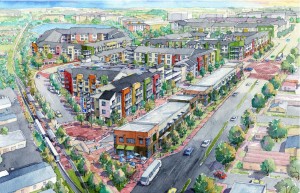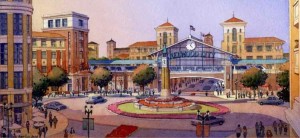
One of the largest Black-owned real estate companies in the country is working with residents of a co-op in San Francisco’s Fillmore neighborhood to redevelop the current sub-standard homes into a $2 billion mega-project of market-rate and affordable housing, plus an innovation center to spur local jobs. Come hear the story from the developers and community leaders themselves at a free lunch ‘n ‘learn webinar at noon PT on Wednesday, April 7th, which I’ll be moderating.
The $2 billion project will transform the Fillmore District and potentially provide a community-based model for housing redevelopment around the country. Rather than being displaced, the current, predominantly African American co-op residents will be able to move into a new eight-story apartment building at no additional cost. The residents will then receive a 15% profit share in the new market-rate units, which include new buildings rising 12 and 18 stories, as the San Francisco Chronicle reported last year.
The webinar will feature:
- Victor McFarlane, chairman and CEO of MacFarlane Partners
- Mattie Scott, President of the Freedom West board of Directors
- Landon Taylor, Co-founder of Legacy First Partners and lead advisor to Freedom West Homes Corp.
The event is organized by the Council of Infill Builders and sponsored by Allen Matkins. Register here!
California is raking in the bucks from its cap-and-trade program. Sales from auctioning off permits to pollute will net the state close to $900 million in this budget year, and it could go to $8 billion a year by 2020, now that transportation fuels are firmly under the cap. Of that amount, about half is dedicated to transportation and infill development that can reduce greenhouse gas emissions. Here is the breakdown on that piece of it:
Transit Capital: $25 million (10% of total auction revenue)
Transit Operations: $25 million (5% of total revenue)
Housing & Sustainable Communities: $130 million (20%)
High Speed Rail: $250 million (25%)
The rest will go to wetland restoration, energy efficiency upgrades for public buildings, and recycling efforts.
 But it’s that $130 million piece that’s been in the news recently (it’s actually $120 million, due to an additional $10 million set-aside for agricultural projects). Called the Affordable Housing and Sustainable Communities (AHSC) Program, state agencies have been trying to adopt the guidelines for disbursing these funds for meritorious land use and transportation projects for over a year. That process was finalized a few weeks ago by the Strategic Growth Council, which issued a complicated set of criteria for project proponents to be eligible to apply.
But it’s that $130 million piece that’s been in the news recently (it’s actually $120 million, due to an additional $10 million set-aside for agricultural projects). Called the Affordable Housing and Sustainable Communities (AHSC) Program, state agencies have been trying to adopt the guidelines for disbursing these funds for meritorious land use and transportation projects for over a year. That process was finalized a few weeks ago by the Strategic Growth Council, which issued a complicated set of criteria for project proponents to be eligible to apply.
According to the new guidelines [PDF], half of the funded projects must provide affordable housing near transit, while the other half must provide benefits for “disadvantaged communities,” per this map.
But the problem is (at least for this first round), $120 million won’t get you very far. Affordable housing projects have a minimum grant award of $1 million and maximum of $15 million, while transit projects in disadvantaged communities have a minimum $500 thousand and maximum $8 million. You can see how that money will go quickly with only $120 million to disburse. As Streetsblog LA reported, Strategic Growth Council staff “expect to be able to fund between 15 and 25 projects in the first round.”
15 to 25 projects is, frankly, not much. And not much to get excited about in this first round. Fortunately, more money will be available later this year in the second round, and an expanding pot of auction funds could mean almost 10 times this amount in a few years, if the $8 billion-by-2020 projection comes true.
But even at 10 times this amount (over $1 billion a year), that’s just a couple hundred projects per year — not enough to make up for the loss of redevelopment funds. These funds were a primary source of infill financing, and the program netted about $5 billion annually statewide until it self-immolated in a 2011 California Supreme Court case.
I hate to be a Debbie Downer, but California will need to do better than this given the extreme housing needs in the state. It’s hard not to look jealously at the high speed rail set-aside and wonder why more of that money is not flowing to transit-oriented housing. After all, high speed rail was sold as a viable public-private investment that would essentially pay for itself. But after voter approval, the route was politically gerrymandered to accommodate powerful political interests. The politically motivated route changes to Palmdale and the eastern San Joaquin Valley drove up the price tag due to more complicated construction, reduced travel speeds between the major population centers, and made the project less attractive to private investors.
Perhaps as more constituents get a taste of cap-and-trade dollars, it will put political pressure on Sacramento leaders to retool the formulas to give more money to transit-oriented housing. It won’t happen while Governor Brown is in office, given his attachment to high speed rail as a legacy project, but I wouldn’t be surprised if it happens before 2020.
It’s a common complaint among infill developers that there’s not enough public support for basic infrastructure upgrades in some of the most transit-friendly neighborhoods. So instead of the community helping to pay for upgraded sewer, power, and water lines, not to mention parks and sidewalks, it often falls to the first developer out of the gate to bear those costs.
This lack of public support has been the norm since redevelopment agencies committed suicide in the California Supreme Court back in 2011, forcing them to be dissolved to save the state some money. These agencies used to have authority to dedicate future increases in local tax revenue to pay back upfront investments in the neighborhoods that would spur economic growth.
I blogged about this situation a few weeks ago, with a write-up of a bill on the governor’s desk to use infrastructure finance districts as a redevelopment substitute. Some political observers fear this new mechanism because it has no limits on where it can be implemented, possibly leading to more infrastructure and investment in sprawl areas.
But there’s a competing measure on the governor’s desk that is more focused on resurrecting redevelopment for low-income areas. AB 2280 (Alejo) would only allow redeveloment to come back in these areas, with a strong focus on allowing developers to build more affordable housing and generate more economic development in these communities. Proponents argue that it’s much more limited in scope than the old redevelopment mechanism and won’t cost the state any money.
AB 2280 could certainly provide a more focused retooling of redevelopment, but it carries the risk of causing more gentrification and not necessarily building more transit-friendly neighborhoods to reduce traffic and air pollution. In fact, the bill has no environmental criteria that I can see, such as limiting application to neighborhoods that are transit-rich or in which more development would help the state meet its environmental goals. Still, lower-income neighborhoods often see higher transit ridership, so AB 2280 could end up being a safe bet for smart growth.
Overall, it’s encouraging to see some new momentum to rebuilding financing mechanisms that could benefit infill infrastructure. But I wish the existing options had stronger environmental criteria to allow the rebirth of redevelopment only in infill areas around the state. Those are the neighborhoods in which we should invest our scarce public resources — not in outlying areas that generate more traffic and pollution.



